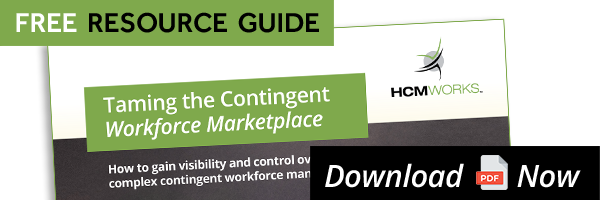Companies are relying more heavily on contingent labor to control rising labor costs, bridge skill gaps in key geographic areas and high-value disciplines, as well as respond to fast-moving market conditions with greater agility.
Experts even speculate that for some global companies, the contingent workforce may represent a higher percent of the total workforce than traditional employees. Whatever the reason for change, managing contingent labor has become strategic and imperative for many companies.
Yet, as companies expand their dependence on outsourcing and third party labor, organizational limitations come into plain view; internal processes and systems are typically not adequate to manage the inherent risks of a contingent labor force, not to mention extract maximum value from this critical resource.
Governments, on the other hand, are reviewing how they scrutinize and regulate contract labor to ensure taxes are paid, and workers aren’t taken advantage of.
With this growth of contingent labor, the overall risk from outsourced talent is on the rise. Companies are looking for quick and efficient risk-mitigation controls that can deliver cross-enterprise standardization, visibility, and compliance.
Companies are taking the necessary steps to drive all third party labor categories to a single onboarding solution that will help ensure easier policy and regulatory compliance, as well as contain these resource categories to their appropriate and relevant access levels.
These are the most common and consequential problems that companies are facing with their contingent workforce:
Regulatory & Compliance Risk:
The use of contingent labor can expose companies to serious legal and regulatory risks. Some organizations may have a difficult time tracking third party labor, and unwittingly take on high levels of compliance-related risk. A company that misclassifies workers may be subject to audits and penalties and further regulations in this area are on the way.
Access & Security:
Many companies impose less stringent security standards on contingent labor than on employed labor without considering the consequences. With fewer contingent labor background checks and less drug testing.
Visibility/Analytics:
Many companies cannot truly assess the total amount of third party labor supporting their company, where those individuals are located (geographically and by job category) and what they have access to.
Technology:
Without an integrated solution to manage vendors, the process of onboarding workers and tracking spending, organizations are ill-equipped to make the strategic decisions necessary to deploy contingent labor efficiently and safely.
There is a firm commitment among organizations to decrease the risks of their contingent workforce as they face increasing risk related to managing contingent labor. The last thing a company wants to deal with is any legal issue regarding their third party labor, especially when their top priority is to improve visibility into all facets of their contingent workforce management.
For more guidance and any questions regarding managing your contingent workers, please contact HCMWorks. Your mind will be put at ease as solutions are presented by one of our Contingent Workforce Solutions Specialists.
About HCMWorks
We are a contingent workforce service provider helping organizations gain better access to talent through the use of independent contractors, consultants, temporary workers, freelancers and other non-payrolled employees. We provide the expertise, the technology, and processes to help you reduce your workforce costs, mitigate against misclassification and co-employment risks, and increase the efficiency and timeliness of your contingent recruitment process. Read more about what our clients say about us here.




